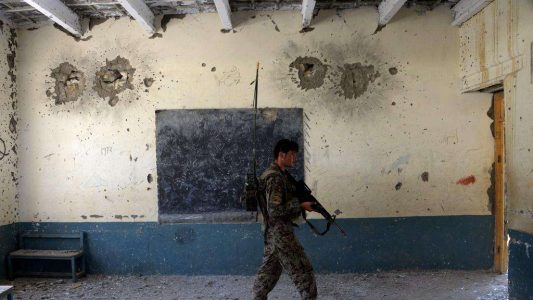
Islamic State recruitment is growing up in Afghanistan
In the shade of a riverside open-air restaurant in Afghanistan’s Jalalabad, Bilal sits cross legged on a pillow, with his eyes scanning the sky and the surrounding area ceaselessly.
He jumps up nervously as the shadow of a bird crosses over his face.
Bilal 28, is a fighter with IS Khorasan – the ISIS branch in Afghanistan – and says that over the past year, they have gained a few thousand fighters in the country, with their funding coming from interests abroad and criminal activity, such as kidnapping.
IS-K has been active in Afghanistan since 2015.
Its fighters pledge allegiance to ISIS command, which once operated out of the eastern Syrian city of Raqqa.
There its members beheaded hostages, raped slaves and killed hundreds over accusations including sorcery.
The Afghan National Army and the US military, as well as the Taliban, fight the extremist group in Afghanistan.
“There are an estimated 4,000 to 6,000 fighters and one fourth of them are foreigners,” says Lt Gen Abdul Hadi Khalid, a researcher at the Afghan Institute for Strategic Studies and former vice minister of interior.
Afghan’s spy agency puts the numbers much lower, saying that only about 3,000 remain and most fighters enter the country through the Iranian-Afghan border.
Bilal, a Pakistani native from a religious lower-middle class family, came to Afghanistan eight years ago, originally joining the Taliban.
But the group’s changing ideology pushed him away and he joined IS-K two years ago.
As the Taliban and the US negotiate a peace deal in Doha, Bilal says he is ready for a violent future.
“With ongoing peace talks, IS-K recruitment has increased,” a government security official tells The National. “This includes recruitment from foreign fighters who are already in Afghanistan, but work with networks in their home countries.
“We will see if they become bigger once a peace deal is signed, but we estimate that around 5-10 per cent of Talibs might join Daesh then.”
Bilal says it was not financial considerations but his personal wish to fight that made him decide to join the group.
“IS-K is giving money and power to people and it’s appealing,” says Mahmood Marhoon, an author and researcher at Kabul University.
“Most of the people who join are young, and while it’s tough to put a finger on exact numbers, the group is definitely stepping up their recruitment.”
The Ministry of Defence’s spokesman, Zubair Arif, insists that 95 per cent of the group has been finished, contrary to other expert opinion.
“We fought hard to remove them in Nangarhar and Kunar,” Mr Arif says. “Many of them are foreigners and enter Afghanistan through all borders, even through Kabul’s international airport.”
The threat is not far-fetched, especially in the country’s eastern provinces of Nangarhar, Kunar and Nuristan, where the group has gained some territory over the past six months, a Pentagon report released in July shows.
“Regionally, the group continues to evade, counter and resist sustained counter-terrorism pressure,” the report said.
According to a new UN report, out of the almost 4,000 civilian casualties in the first months of 2019, 11 per cent could be attributed to IS-K.
The Taliban and IS-K have been fighting each other, often for ideological reasons.
Both groups accuse each other of not being Islamic. In the past year, IS-K has taken over large forest areas, previously under Taliban control, with a booming wood and mining industry helping fund their activities.
“Daesh is also gaining strength in eastern Afghanistan because they are fighting ideologically,” explains Nadir, 35, a former Taliban trainer. After 12 years of educating fighters in suicide attack methods, Nadir, has left the insurgents behind to focus on his university studies.
“The Taliban’s ideology is becoming weak and it means that several of their fighters have joined Daesh – including Bilal,” he says.
IS-K territory is mainly constrained to eastern Afghanistan, yet new, small pockets are emerging across the country.
“We see them in the north, in provinces like Takhar and Badakhshan,” explains Lt General Khalid.
“Salafism is active in some northern areas and that’s where IS-K is finding ground.”
Bilal says the Taliban has changed. “They are not fighting infidels anymore, but they come to the negotiation table with them.”
He says that the group has managed to set up a semi-functioning state system, including schools, courtrooms and medical centres. “Some women have even joined their husbands here.”
“Local people see our good laws and want to join us. The young men I know – some of them are Uzbeks, Indians, Iranians, Chinese, even a few Europeans – want to give their lives,” Bilal says.
“People have been brainwashed,” explains former terrorist trainer Nadir, who is using a fake name to conceal his identity. He’s known Bilal for many years, having once taught him how to build suicide vests.
But, for Bilal, joining the fighting was a decision he made after studying in one of Pakistan’s religious schools.
“Foreign forces have come here to attack us and destroy our home, so we have to do the same,” the young man explains. “We do this to terrorise people and stir fear,” he says.
A few years ago, his family from Pakistan’s Karachi visited him in Afghanistan, an uncommon move. “My mother came to find me a wife, but I refused,” he says. “I live right on the front line and if I die, my wife would be alone.” He now shares a house with two other single Pakistani fighters.
Bilal says he has come to Jalalabad to catch up with friends, but he’s manoeuvring through the city by avoiding checkpoints and hiding from the police.
“We’re targeting people, but we’re also a target here,” Bilal explains. “It’s only in the Daesh areas that I feel safe.”
Source: The National





